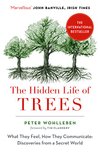
The Hidden Life of Trees: The International Bestseller

Trees offer considerably more than just food. Animals abuse young trees by using them as convenient rubbing posts.
Peter Wohlleben • The Hidden Life of Trees: The International Bestseller
As their upward growth slows, their defenses against fungi disappear. One broken-off branch is enough to provide a port of entry.
Peter Wohlleben • The Hidden Life of Trees: The International Bestseller
Under the giants’ bare branches, Liverleafs & Co. seize the opportunity to produce the carbohydrates they need for the following year.
Peter Wohlleben • The Hidden Life of Trees: The International Bestseller
Many trees in North America are adapted to natural cycles of ground fires.
Peter Wohlleben • The Hidden Life of Trees: The International Bestseller
In essence, then, trees disinfect their surroundings. But that isn’t all.
Peter Wohlleben • The Hidden Life of Trees: The International Bestseller
The scientist counted 2,041 animals belonging to 257 different species.48 Tree crowns even contain specialized wetland habitats.
Peter Wohlleben • The Hidden Life of Trees: The International Bestseller
When I think about the research results, in particular in conjunction with the crackling roots I mentioned earlier, it seems to me that these vibrations could indeed be much more than just vibrations—they could be cries of thirst.
Peter Wohlleben • The Hidden Life of Trees: The International Bestseller
Coppicing was popular because people were so poor in those days that they couldn’t afford to wait any longer for new wood.
Peter Wohlleben • The Hidden Life of Trees: The International Bestseller
Fruit trees, willows, and chestnuts use their olfactory missives to draw attention to themselves and invite passing bees to sate themselves.